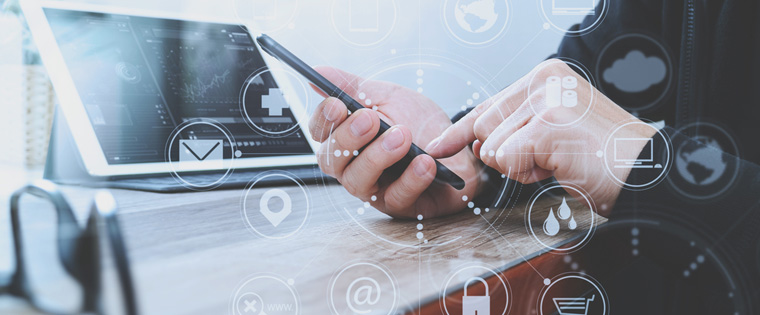5 Ideas to Build an Engaging Mobile Learning Experience

Did you know that about 2 billion people (51% of global users) access the Internet only through their smartphones? It’s hard to imagine a time without them, isn’t it? And yet, only two decades ago, mobile phones were a luxury, seen only in the hands of the rich and the famous. Today, the number of mobile users, as well as the range of devices, keeps on increasing steadily. We have smartphones, tablets, iPads, laptops, chrome books, and many more. As things stand, is it shocking that 74% of your employees access resources from their mobile devices? Mobile learning has justly moved on from being a nice-to-have training format to a must-have training strategy.
→ Download whitepaper on mobile learning design best practices.
Mobile learning:
- Allows remote access to information at the moment of need
- Enables learners to set the pace of learning and allows flexibility of time and place
- Facilitates social interaction between learners and quick transfer of knowledge
- Improves learner engagement by providing a seamless and uninterrupted learning experience
The fourth point is where most training managers face problems. Engaging remote learners through small screens is not the same as engaging learners sitting behind desktops. Also, mobile learning is not just about converting traditional eLearning courses to fit the device size. So, what can you do?
How to Improve Mobile Learning Engagement?
5 Cool Tips
- Go for microlearning courses
- Encourage collaboration through social media
- Leverage video-based learning
- Personalize and customize learning
- Employ game mechanics
Here are a few ideas that will enhance the mobile learning experience.
Ways to Improve Mobile Learning Experience
1. Go for Microlearning Courses with its Bite-sized learning
Are you aware of the phenomenon called ‘scrolling fatigue’? It sure sounds exotic, but it isn’t. We have all been a victim of this. It is the state when you are so tired of going through the content in your mobile devices that you simply keep scrolling down without even looking at or registering the information.
It sounds like a challenge for mobile learning, right? It isn’t the only one.
Several factors can hamper a mobile learning experience – limited battery life, small screen size, fickle Internet access and worst of all, social media distractions. So, mobile learning and hour-long eLearning courses are not a match made in heaven. However, you can use bite-sized learning modules to engage learners and enhance their mobile learning experience.
Microlearning courses are only 10-15 minutes long and are tailored around one learning objective. They are best in giving away information without letting learners get distracted. Microlearning courses can be configured in multiple formats, making learning more flexible and less monotonous. They can be as diverse as videos, animations, quizzes, flashcards, infographics, and mobile apps.
2. Encourage Collaboration through Social Media
‘When life gives you lemons, make lemonade.’ That’s a very popular saying which encourages us to make the most of a difficult situation. So, if you are worried about your learners getting distracted with social media while on their mobile devices, turn the table and start using these platforms as training avenues.
Social media connects people and helps in the exchange of ideas, right? Use it to connect learners to SMEs, industry experts, their peers, and supervisors and open the doors to new ideas and thoughts. Create pages, groups, and discussion boards where they can share their opinions, experiences, and discuss new trends. Encourage collaborative projects between employees to build teamwork and leadership skills.
Social media shares a tight knot with mobile devices. Make the most out of the situation and use social learning mediums to enhance mobile learning experience.
3. Leverage Video-based Learning
Did you know that 500 hours of fresh videos are uploaded on YouTube every minute? Videos are the most popular format of content consumption on a mobile device. They are easy to develop and update, easy to access, crisp, succinct, fast, and trendy. And when it comes to training, they very successful in engaging learners.
Mobile learning videos can be in many formats – text-based, animations, web-cats, and user-generated. You can easily convert any conventional video into an eLearning course by adding interactivities. For an effective mobile learning experience, you can use microlearning videos which can serve as standalone courses to explain concepts, solve problems, or summarize, and also can be a part of any learning journey.
4. Personalize and Customize Learning
Your mobile devices are your personal devices, aren’t they? Don’t you think personalizing what you access through these devices will leave a deeper impact? The mobile learning experience for a learner can be made more successful through personalization. You can achieve it by:
- Leveraging microlearning courses to create individual learning paths.
- Repurposing learning content into different formats to give learners a choice on how they want to learn.
- Allowing learners choice in simple things such as the screen orientation as they prefer.
5. Employ Game Mechanics
What is your most played mobile game? Is it PUBG, Fortnite, FIFA, or Candy Crush? Do you spend your free time-solving Sudoku on your phone or tune-in your mental prowess with a game of chess? Whatever your choice is, you can probably relate to the fascination games hold for many people, young and old alike. And when game mechanics are used for training, the learning process immediately becomes more fun and engaging.
- Gamifying mobile learning brings edutainment into training. It shows that learning can be both serious and fun.
- They incite healthy competition and gratify learners with rewards and points.
- Gamification in combination with mobile learning also makes up for successful job aids. They allow learners to access information when in need and also encourage exploration and decision making.
Summing it Up!
The mobile revolution has changed the world for the better in the last decades, making it more open and connected. As we become more global, our lives are becoming more mobile, even corporate training. More and more companies now have a BYOD (Bring Your Own Device Policy) and they need to have a mobile-first learning strategy. So, keep these pointers in mind while devising a mobile learning plan for your organization.
And if you want any more information, download our eBook.





